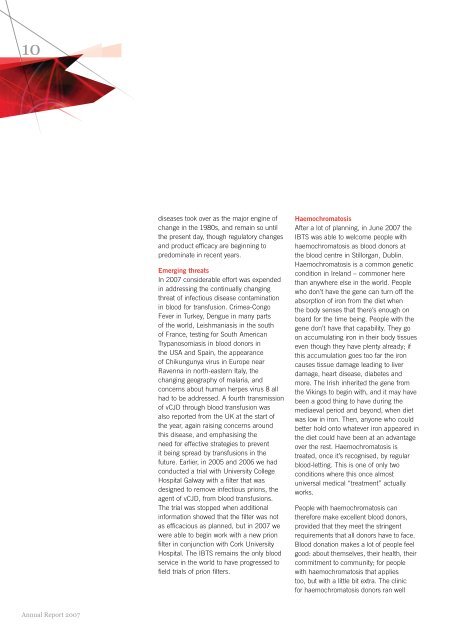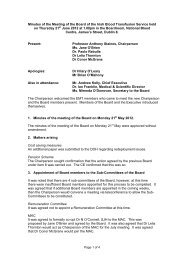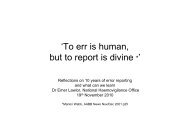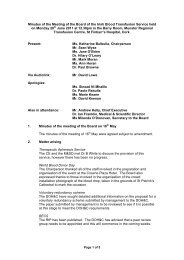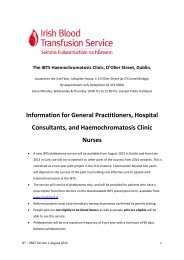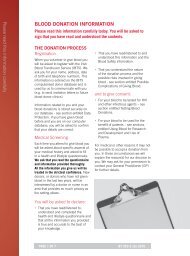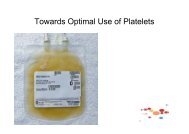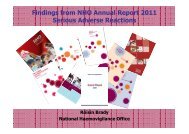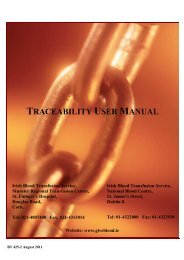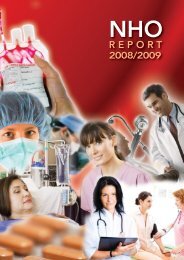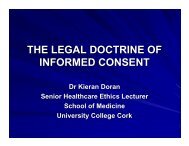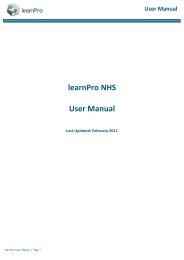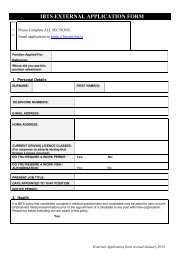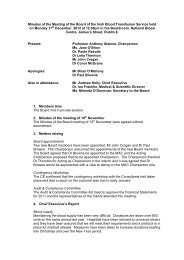IBTS Annual Report 2007.pdf - Irish Blood Transfusion Service
IBTS Annual Report 2007.pdf - Irish Blood Transfusion Service
IBTS Annual Report 2007.pdf - Irish Blood Transfusion Service
Create successful ePaper yourself
Turn your PDF publications into a flip-book with our unique Google optimized e-Paper software.
10<br />
diseases took over as the major engine of<br />
change in the 1980s, and remain so until<br />
the present day, though regulatory changes<br />
and product efficacy are beginning to<br />
predominate in recent years.<br />
Emerging threats<br />
In 2007 considerable effort was expended<br />
in addressing the continually changing<br />
threat of infectious disease contamination<br />
in blood for transfusion. Crimea-Congo<br />
Fever in Turkey, Dengue in many parts<br />
of the world, Leishmaniasis in the south<br />
of France, testing for South American<br />
Trypanosomiasis in blood donors in<br />
the USA and Spain, the appearance<br />
of Chikungunya virus in Europe near<br />
Ravenna in north-eastern Italy, the<br />
changing geography of malaria, and<br />
concerns about human herpes virus 8 all<br />
had to be addressed. A fourth transmission<br />
of vCJD through blood transfusion was<br />
also reported from the UK at the start of<br />
the year, again raising concerns around<br />
this disease, and emphasising the<br />
need for effective strategies to prevent<br />
it being spread by transfusions in the<br />
future. Earlier, in 2005 and 2006 we had<br />
conducted a trial with University College<br />
Hospital Galway with a filter that was<br />
designed to remove infectious prions, the<br />
agent of vCJD, from blood transfusions.<br />
The trial was stopped when additional<br />
information showed that the filter was not<br />
as efficacious as planned, but in 2007 we<br />
were able to begin work with a new prion<br />
filter in conjunction with Cork University<br />
Hospital. The <strong>IBTS</strong> remains the only blood<br />
service in the world to have progressed to<br />
field trials of prion filters.<br />
Haemochromatosis<br />
After a lot of planning, in June 2007 the<br />
<strong>IBTS</strong> was able to welcome people with<br />
haemochromatosis as blood donors at<br />
the blood centre in Stillorgan, Dublin.<br />
Haemochromatosis is a common genetic<br />
condition in Ireland – commoner here<br />
than anywhere else in the world. People<br />
who don’t have the gene can turn off the<br />
absorption of iron from the diet when<br />
the body senses that there’s enough on<br />
board for the time being. People with the<br />
gene don’t have that capability. They go<br />
on accumulating iron in their body tissues<br />
even though they have plenty already; if<br />
this accumulation goes too far the iron<br />
causes tissue damage leading to liver<br />
damage, heart disease, diabetes and<br />
more. The <strong>Irish</strong> inherited the gene from<br />
the Vikings to begin with, and it may have<br />
been a good thing to have during the<br />
mediaeval period and beyond, when diet<br />
was low in iron. Then, anyone who could<br />
better hold onto whatever iron appeared in<br />
the diet could have been at an advantage<br />
over the rest. Haemochromatosis is<br />
treated, once it’s recognised, by regular<br />
blood-letting. This is one of only two<br />
conditions where this once almost<br />
universal medical “treatment” actually<br />
works.<br />
People with haemochromatosis can<br />
therefore make excellent blood donors,<br />
provided that they meet the stringent<br />
requirements that all donors have to face.<br />
<strong>Blood</strong> donation makes a lot of people feel<br />
good: about themselves, their health, their<br />
commitment to community; for people<br />
with haemochromatosis that applies<br />
too, but with a little bit extra. The clinic<br />
for haemochromatosis donors ran well<br />
<strong>Annual</strong> <strong>Report</strong> 2007


